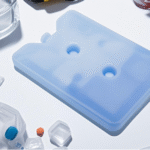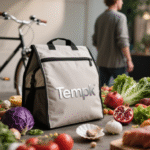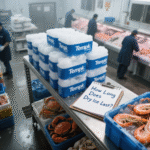TroyicePackcells36Pack: Should You Upgrade Your Frozen Shipping?
Shipping frozen foods or biologics? A dry ice pack cells 36 pack offers modular, –78 °C cooling that lasts 72 hours yet fits standard liners. This playbook shows you load formulas, gear choices, Und 2025 rules so you never gamble with thaw risk again.

-
How does a 36‑cell dry‑ice pack outperform loose pellets?
-
How many packs do you need for 24‑, 48‑, and 72‑hour routes?
-
Which coolers pair best with cell‑based dry ice in 2025?
-
What safety, hazmat, and disposal steps keep teams compliant?
-
How can you blend gel packs with 36‑cell units for hybrid lanes?
What Exactly Is a Dry Ice Pack Cells 36 Pack?
A 36‑cell dry‑ice pack is a perforated sheet of 36 mini blocks (≈ 25 g each) sealed in a breathable film that vents CO₂ while locking shape. Unlike loose nuggets, cells stay flat, stacking neatly to maximize surface contact and slash sublimation by ~12 %.
Typical specs:
| Attribute | Value | Benefit |
|---|---|---|
| Cell size | 40 × 40 × 15 mm | Even cooling grid |
| Nettogewicht | 900 g | Predictable load math |
| Vent rate | 0.8 L CO₂/h | Meets IATA PI 954 |
How Many 36‑Cell Packs Do You Need?
Rule of thumb: one sheet per 1 kg frozen payload for 24 h; two sheets for 48 h; three for 72 h. Layer packs on top—cold sinks downward.
| Frozen Payload (kg) | 24 h Sheets | 48 h Sheets | 72 h Sheets |
|---|---|---|---|
| 2 | 2 | 4 | 6 |
| 5 | 5 | 10 | 15 |
| 10 | 10 | 20 | 30 |
Pro Tip: Pre‑chill the box at –20 °C for 3 h to extend hold time 10–15 %.
Why Upgrade to 36‑Cell Packs Over Pellets?
-
Uniform Cooling: Cells distribute –78 °C evenly, cutting hot spots.
-
Faster Loading: Sheets slide in like pizza boxes—no scooping pellets.
-
Cleaner Unboxing: End users handle a tidy sheet, not loose fragments.
-
Lower Hazmat Weight: Modular sheets let you stay under the 2.5 kg airline exemption.
Field Example
A specialty gelato brand replaced pellets with five 36‑cell sheets per 4 kg order and dropped melt claims from 7 % to 1 % during 48‑h summer deliveries.
Cooler Pairing & Layering Tips
-
R‑Value ≥ 4 m² K/W liners (aerogel or VIP) slow sublimation.
-
Use a corrugated spacer between product and ice sheet to curb freeze‑burn.
-
Fill voids with recyclable paper pads for best thermal efficiency.
Sicherheit & Compliance: 2025 Checklist
-
Label “UN 1845 Dry Ice” + net weight on two faces.
-
Keep total dry ice ≤ 2.5 kg per box to skip full Class 9 docs.
-
Vent area 20–30 mm²; the sheet’s film already micro‑vents CO₂.
-
Wear loose, insulated gloves—contact frostbite occurs in < 5 s.
-
Let leftover sheets sublimate in a well‑ventilated space; recycle film where accepted.
Following these steps meets 49 CFR and IATA PI 954 standards.
2025 Trends: Smarter, Greener Cell‑Based Dry Ice
-
Brewery‑captured CO₂ now fuels carbon‑negative dry‑ice sheets, shrinking footprint 28 %.
-
Bi‑directional NFC tags embedded in sheet corners log temperature and sublimation rate.
-
Plant‑based films compost in 180 days without performance loss.
Market data shows modular dry‑ice packs gaining 11 % market share over pellets as e‑commerce frozen food booms.
FAQ
Can I reuse a 36‑cell sheet after it sublimates?
Yes—refill services reload CO₂ into returned films, cutting waste.
Do the cells sweat like gel packs?
No liquid; sheets sublimate directly to gas, keeping boxes dry.
Are 36‑cell sheets safe for air freight?
Under 2.5 kg per package with vented packaging is fully airline‑compliant.
Zusammenfassung & Nächste Schritte
Der dry ice pack cells 36 pack delivers flat‑pack convenience, consistent –78 °C cooling, and hassle‑free unboxing. Follow the load chart, pair with high‑R insulation, and watch spoilage drop below 2 % on 72‑hour lanes.
Action plan:
-
Estimate sheet count with our online calculator.
-
Request a sample set (5, 10, 15 sheets).
-
Run a lane test—share data for a 10 % reorder credit.
About Tempk
We engineer recyclable thermal solutions that beat bulky foam. Our AeroFlex™ liners and 36‑cell dry‑ice sheets keep cargo at –30 °C for 60 h yet fold flat for return shipping.
Need guidance? Book a free consult.























